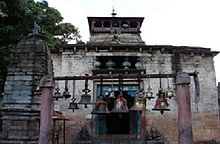Bagnath Temple
| Bagnath Temple | |
|---|---|
बागनाथ थान | |
 Bagnath Temple jai shiv in Bageshwar | |
| Religion | |
| Affiliation | Hinduism |
| District | Bageshwar |
| Deity | Shiva |
| Festivals | Diwali , Shiv ratri and Uttarayani Fair |
| Location | |
| Location | Bageshwar |
| State | Uttarakhand |
| Country | India |
| Geographic coordinates | 29°50′12″N 79°49′21″E / 29.83667°N 79.82250°E |
| Architecture | |
| Type | nagara |
| Creator | Laxmi Chand |
| Completed | 1602 |
| Specifications | |
| Temple(s) | 1 |
| Monument(s) | 3 including (bagnath temple, lord shiva statue, confluence of 2 rivers) |
| Elevation | 1,004 m (3,294 ft) |
Bagnath Temple (Kumaoni: बागनाथ थान) is an ancient shrine dedicated to Shiva, situated in the Bageshwar city at the confluence of Sarayu and Gomati rivers.[1][2] Bagnath Temple is festooned with bells of all sizes and features impressive carvings.[3] It is the most famous Temple in Bageshwar District.[4] It is flooded with devotees on the occasion of Shivratri.[5] The city of Bageshwar gets its name from this Temple.[6][7]
Geography[edit]
Bagnath Temple is located at 29.8370° N, 79.7725° E.[8] The temple is situated in Bageshwar City[9] in Bageshwar District[10] in the Indian state of Uttarakhand. It is situated at the confluence of Saryu and Gomati rivers. It has an Elevation of 1004 m above mean sea level.[11]
History[edit]

According to Hindu Legend, Sage Markandeya worshipped Shiva here.[12][11] Lord Shiva blessed sage Markandeya by visiting here in the form of a Tiger.[12][11]
Though some sources state The existence of Bagnath temple since 7th Century,[7] the present building in nagara style was built in 1450 by Chand ruler, Laxmi Chand.[6][13][14] The various statues in the temple date back from 7th century AD to 16th century AD.[15] In 1996, the Archeology department of Uttarakhand state took over the temple, following which, several inscriptions and idols from the eighth to the tenth century were sealed inside the temples. These include idols of Shiva, Ganesha, Vishnu, Chaturmukhi Shiva, Teen Mukhi Shiva, Panch Mukhi Shiva, Mahishasura Mardini, Sahasra Shivalinga, Ganesh, Karthikeya, Panchdevapath, Navagraha etc.[16]
The significance of the temple finds mention in the Skanda Purana.[15] Hindu Pilgrims file in throughout the year to worship here.[3] A water police post was opened in the premises of the temple on 19 September 2016 for patrolling and prevention of water crimes in the city.[1]
Festivals and Religious Practices[edit]
The Uttarayani fair is held in the month of January every year on the occasion of Makar Sankranti.[6][15][17] The religious ritual of the fair consists in bathing before daybreak at the confluence.[18][19] After Bathing, an offering of water to Lord Shiva inside the Temple is essential.[18] Those who are more religiously disposed, continue this practice for three days in succession, which is known as "Trimaghi".[18]
Gallery[edit]
References[edit]
- ^ a b Singh, Kautilya; Chakrabarty, Arpita (21 September 2016). "Water police post opens in Bageshwar to tackle drowning incidents, crimes". The Times of India. Almora. TNN. Retrieved 15 October 2016.
- ^ "Bagnath temple". travelomy.com. Archived from the original on 3 December 2017. Retrieved 29 October 2012.
- ^ a b Singh, Sarina (15 September 2010). India. Ediz. Inglese. Lonely Planet. p. 498. ISBN 9781742203478.
- ^ Kumar, Brajesh (2003). Pilgrimage Centres of India. Diamond Pocket Books (P) Ltd. p. 96. ISBN 9788171821853.
- ^ "Terror threat fails to deter devotees". The Tribune. Dehradun. Press Trust of India. 7 March 2016. Retrieved 15 October 2016.
- ^ a b c Nag, Prithvish (1999). Tourism and Trekking in Nainital Region. Concept Publishing Company. p. 83. ISBN 9788170227694.
- ^ a b Kasniyal, B D (15 May 2016). "Development gains elude Kumaon's holy place". The Tribune. Pithoragarh. Retrieved 15 October 2016.
- ^ "Bagnath Temple (Shri Bagnathji) Complex". wikimapia.org. Retrieved 15 October 2016.
- ^ Chamaria, Pradeep (1996). Kailash Manasarovar on the Rugged Road to Revelation. Abhinav Publications. p. 83. ISBN 9788170173366.
- ^ Sharma, Dr Shiv (2008). India - A Travel Guide. Diamond Pocket Books (P) Ltd. p. 260. ISBN 9788128400674. Retrieved 15 October 2016.
- ^ a b c Negi, Sunil (18 May 2017). "कत्यूर व चंद शासकों के काल में बनी ऐतिहासिक इमारतें हैं उपेक्षित". JNN (in Hindi). Bageshwar: Dainik Jagran. Retrieved 24 May 2017.
- ^ a b "बाघ और गाय बनकर इस संगम पर घूमते थे भगवान शिव और पार्वती". Dehradun: Amar Ujala. 30 May 2016. Retrieved 15 October 2016.
- ^ Guides, Rough (3 October 2016). The Rough Guide to India. Rough Guides Limited. ISBN 9780241295397. Retrieved 15 October 2016.
- ^ "Bagnath Temple (Bageshwar)". onlytravelguide.com.
- ^ a b c District Census Handbook: Bageshwar (PDF) (Series-6 Part XII-B ed.). Dehradun: Directorate of Census Operations, Uttarakhand. 2011. Retrieved 15 October 2016.
- ^ "बागेश्वर में पुरातत्व विभाग की कैद में आठवीं सदी के शिलालेख, नहीं हो पा रही पूजा". Hindustan (in Hindi). Haldwani. 18 October 2017. Retrieved 10 April 2020.
- ^ "पतित पावनी सरयू-गोमती नदी का संगम गंदगी मुक्त हुआ". Amar Ujala Bureau (in Hindi). Bageshwar: Amar Ujala. 26 December 2016. Retrieved 24 May 2017.
- ^ a b c Pant, Shiva Darshan (1988). The Social Economy of the Himalayans: Based on a Survey in the Kumaon Himalayas. Mittal Publications. p. 197. Retrieved 15 October 2016.
- ^ "Choliya dances enthrall at Bageshwar mela". The Times of India. Almora. TNN. 14 June 2016. Retrieved 15 October 2016.

